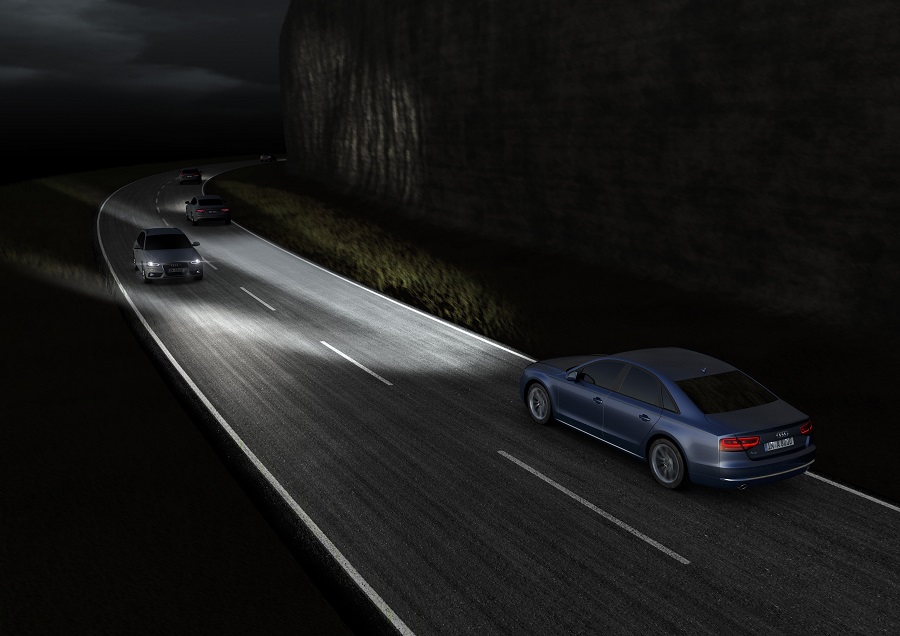Matrix LED headlights are a big trend amongst automotive OEMs nowadays, but what are they, and how do they affect our roads?
Somewhat peculiarly, headlights are a bit of a hot topic these days. As car brands continually look to out-do each other, the simple headlight has become a target for innovation, and individualization, rather than just maintenance. And hey, brighter, whiter, fancier lighting is all well and good… but not if it means that you’re blinding everyone else on the road around you.
In fact, I’m pretty sure that everyone reading this right now has experienced the annoyance of an oncoming high-end car shining its piercing white/blue lights towards you. Plus, the rise in popularity of SUVs means that those of us who still drive sensible cars are more likely to encounter those strong beams at eye level. While it may only last for a few seconds as they pass by, it’s still enough of a disturbance to be noteworthy; noteworthy enough for there to be an entire subreddit dedicated to hatred of modern headlight glare!
However, never ones to shy away from tech innovations – or USPs – car brands have come up with a solution. This is where Matrix LED headlights come into their own.
What are Matrix LED headlights?
In simple terms, these headlights are made up of a many LEDs, arranged in blocks of columns and rows. Check out our guide to LED headlights to understand the core technology at play here. However, in addition to all of those LEDs, Matrix headlights make use of several mirrors, sensors and even cameras.
That supporting hardware surveys the road ahead and instructs individual LEDs to either dim or shine. There are a few different uses for this, including the ability for the car’s headlights to ‘follow’ your path/lane more precisely. But, more relevant to the points made in the intro, Matrix LED headlights will also adaptively shut off certain beams so as to avoid shining into the path of other drivers. In practice, that means you can have your full beams ablaze wherever you go, and you won’t dazzle a single soul.
For a visual demonstration, watch the Audi promo clip above.
Extra Functionality
As well as the core purpose of illuminating the road ahead, Matrix LED headlights have evolved to do all sorts of other things too. Some are undoubtedly gimmicky, whereas others arguably serve a valid road safety purpose.
First off, there’s speed sensitivity. What I mean by this is that some OEMs produce headlights which will shine further once you hit a certain speed threshold. The idea here is that the faster you go, the greater depth of vision you’ll need. For example, Land Rover’s system will give you extra range beyond 50mph, while the Volkswagen-Audi Group system adapts at 40mph.
As well as pure light, some high-end Matrix systems will also use their LEDs to display animations or icons. Some serve genuine purposes, such as warning the driver of hazards ahead or laying down a crosswalk for pedestrians, but others are mere vanity items. The video above highlights several examples of this, so to get an idea of what it’s like to drive a car with Matrix LED headlights, give it a watch. Though, do bear in mind that each car’s system is unique, so this Audi A8 might have different LED functions to, for example, a Land Rover Defender.
Automatic High Beam Assist LEDs
As mentioned above, with the ability to disable LEDs within the light cluster, you can drive at night using full beam. I recently used this feature in a Porsche 911 GT3 test car. It’s a fascinating piece of technology, as what it does is shut off the LEDs that direct light onto oncoming drivers, while also still illuminating the oncoming car’s surroundings. This is a particularly useful function if you live in areas that are poorly lit. At first it sounds a bit like a gimmick, and certainly something that you wouldn’t use; how difficult is it to remember to turn your high beam assist off when driver’s are coming towards you? Well, if you’ve ever done any night-time driving, you’ll realize that for some this appears to be a difficult task…
It’s arguably peak laziness, but nonetheless it’s a useful feature and enables you to light up the whole road in front of you without affecting other drivers’ vision. Better still, it detects where the oncoming car is and continues to track it until it passes, meaning you don’t have to worry when they’re almost alongside you.





